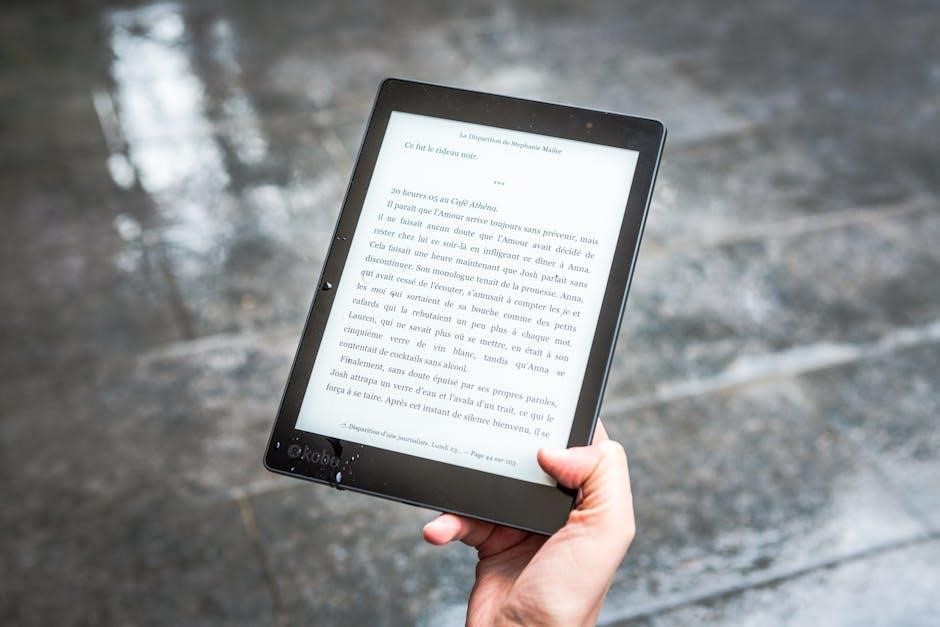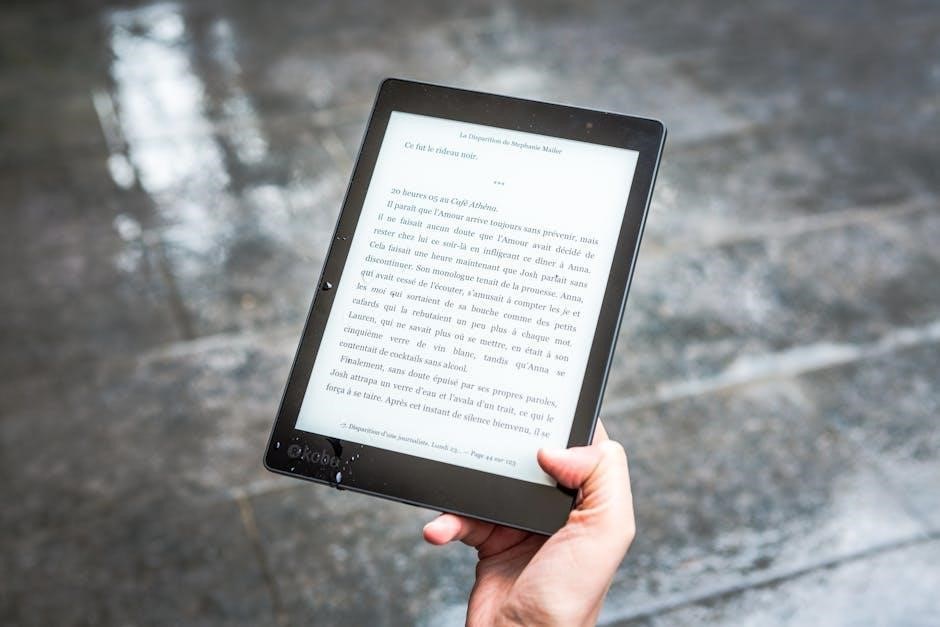Søren Kierkegaard’s Either/Or (1843) is a foundational philosophical work exploring the conflict between the aesthetic and ethical lifestyles‚ offering profound insights into human existence.
Structure of “Either/Or”
Either/Or is divided into two volumes‚ each presenting contrasting perspectives on life. Volume I focuses on the aesthetic‚ written by an anonymous figure‚ while Volume II explores the ethical‚ authored by Judge Vilhelm‚ offering a philosophical debate between hedonism and morality.
2.1. Volume I: The Aesthetic Life
Volume I of Either/Or explores the aesthetic life through the perspective of an anonymous “A‚” who embodies hedonism and individualism. This section delves into immediate experiences‚ sensations‚ and the pursuit of pleasure‚ rejecting external moral frameworks. It includes fragments like aphorisms‚ essays on art and boredom‚ and the infamous “The Seducer’s Diary‚” which portrays a manipulative relationship. The aesthetic life is depicted as fleeting and self-centered‚ contrasting sharply with the ethical life in Volume II‚ highlighting Kierkegaard’s critique of a life devoid of deeper meaning or commitment.
2.2. Volume II: The Ethical Life
Volume II of Either/Or‚ authored by Judge Vilhelm‚ presents the ethical life as a contrast to the aesthetic. It emphasizes commitment‚ responsibility‚ and the fulfillment of moral duties. Marriage is central‚ viewed as a sacred institution that embodies ethical continuity and love. The judge critiques the hedonism of Volume I‚ advocating for a life grounded in duty and moral accountability. This volume underscores the ethical life’s stability and purpose‚ offering a profound alternative to the fleeting nature of aesthetic existence‚ thus completing Kierkegaard’s exploration of human existence.
Main Characters in “Either/Or”

The two main characters‚ Character A and Judge Vilhelm‚ represent the aesthetic and ethical lifestyles‚ respectively‚ embodying the central conflict explored in the book.
3.1. Character A: The Aesthetic Life
Character A embodies the aesthetic life‚ focusing on hedonism‚ passion‚ and immediate experiences. Through his writings‚ including “The Seducer’s Diary‚” he illustrates a life driven by desire and sensuality. A’s perspective is fragmented and introspective‚ often expressing a sense of melancholy and inner conflict. His philosophy rejects long-term commitments‚ instead embracing fleeting moments of pleasure. This character serves as a critique of a life devoid of ethical responsibility‚ highlighting the existential tension explored throughout the book.
3.2. Judge Vilhelm: The Ethical Life
Judge Vilhelm represents the ethical life in Either/Or‚ advocating for a life of duty‚ morality‚ and commitment. His essays in Volume II emphasize the importance of marriage and ethical responsibility‚ contrasting with Character A’s hedonism. Vilhelm argues that true fulfillment is found in making choices that align with societal norms and personal accountability. He believes in the transformative power of commitment‚ particularly through marriage‚ as a way to transcend the fleeting nature of aesthetic desires. His perspective offers a structured‚ rational alternative to A’s chaotic‚ introspective world.

Key Themes in “Either/Or”
Either/Or explores the tension between aesthetic and ethical life‚ the necessity of choice‚ and the societal role of marriage‚ offering deep philosophical reflections on existence and responsibility.
4.1. The Aesthetic vs. The Ethical
The aesthetic life in Either/Or revolves around immediate experiences‚ personal pleasure‚ and spontaneity‚ epitomized by Character A’s hedonism. In contrast‚ the ethical life‚ represented by Judge Vilhelm‚ emphasizes moral responsibility‚ duty‚ and commitment. Kierkegaard juxtaposes these two existences‚ highlighting their inherent conflicts and the individual’s struggle to choose between a life of fleeting desires and one of principled dedication. This dichotomy forms the philosophical core of the book‚ exploring the human condition’s complexities.
4.2. The Concept of Choice
The concept of choice in Either/Or is central‚ as it presents a profound dilemma between two lifestyles: the aesthetic and the ethical. Kierkegaard emphasizes that true freedom lies in making a choice‚ which defines one’s identity and purpose. The book leaves the resolution of this choice to the reader‚ underscoring the subjective nature of existence. This existential decision reflects the human condition’s inherent responsibility to choose‚ aligning with Kierkegaard’s broader philosophical themes of self-determination and the burden of freedom.
4.3. The Role of Marriage
In Either/Or‚ marriage is portrayed as a cornerstone of the ethical life‚ symbolizing commitment and moral responsibility. Judge Vilhelm argues that marriage transcends romantic love‚ offering stability and a framework for self-realization. It represents a choice that balances individual desire with duty‚ embodying the ethical lifestyle. Marriage‚ in this context‚ is not merely a romantic decision but a profound moral commitment that reflects the ethical ideal of fidelity and shared life. This perspective contrasts sharply with the fleeting nature of aesthetic pursuits‚ highlighting marriage’s enduring significance in Kierkegaard’s philosophy.

Key Sections of the Book
Either/Or includes two volumes‚ with Volume I focusing on “The Seducer’s Diary‚” exploring aesthetic desires‚ and Volume II presenting “The Aesthetic Validity of Marriage‚” advocating ethical commitment.
5.1. “The Seducer’s Diary”

“The Seducer’s Diary” is a central narrative in Volume I of Either/Or‚ detailing the aesthetic life through Character A’s pursuit of pleasure and seduction. It chronicles his manipulative relationship with Cordelia‚ showcasing his hedonistic philosophy. The diary reflects the aesthetic mindset‚ prioritizing immediate experiences and desires over ethical commitments. Through its vivid storytelling‚ it contrasts sharply with the ethical arguments presented in Volume II‚ highlighting the tension between aesthetic indulgence and moral responsibility. This section remains a pivotal exploration of Kierkegaard’s philosophical themes.
5.2. “The Aesthetic Validity of Marriage”
“The Aesthetic Validity of Marriage” is a pivotal essay in Volume II of Either/Or‚ written by Judge Vilhelm. It argues for the ethical and aesthetic value of marriage‚ countering the hedonistic views of Character A. Vilhelm posits that marriage combines sensual love with moral commitment‚ creating a balanced and meaningful life. He critiques the transient nature of aesthetic pleasure‚ advocating instead for the enduring‚ ethical choice of marriage. This section underscores Kierkegaard’s exploration of how the ethical life transcends the aesthetic‚ offering a deeper sense of fulfillment and purpose.
Philosophical Implications
Either/Or explores existential themes‚ emphasizing individual choice and subjective experience. It highlights the conflict between aesthetic hedonism and ethical responsibility‚ influencing existentialist thought and modern philosophy.
6.1. Existentialism and Subjectivity
Kierkegaard’s Either/Or is a cornerstone of existentialism‚ emphasizing individual choice and subjective experience. It explores the internal struggle between aesthetic pleasure and ethical commitment‚ highlighting the personal responsibility of selecting a lifestyle. The book’s pseudonymous authorship reflects Kierkegaard’s belief in diverse perspectives‚ encouraging readers to embrace their unique existence. This philosophical framework influenced later existentialists like Jean-Paul Sartre‚ who also stressed freedom and personal accountability; The text remains a vital exploration of human subjectivity and the quest for meaning in life.
6.2. The Influence of “Either/Or” on Philosophy

Either/Or profoundly influenced existentialism by emphasizing individual choice and subjective experience. It shaped thinkers like Jean-Paul Sartre‚ highlighting freedom and personal responsibility. The book’s exploration of aesthetic vs. ethical lifestyles inspired philosophical debates on authenticity and meaning. Its impact extends beyond philosophy‚ influencing literature and theology‚ cementing Kierkegaard’s legacy as a pioneer of existential thought. The text’s enduring relevance underscores its significance in understanding human existence and the pursuit of authentic living.

Availability of “Either/Or” in PDF Format
Either/Or is widely available in PDF format‚ with free downloads accessible through platforms like the Digital Library of India and various academic repositories‚ ensuring easy access globally.
7.1. Sources for Downloading “Either/Or” PDF
Either/Or in PDF format is accessible through various online platforms‚ including the Digital Library of India‚ Google Books‚ and academic repositories like Princeton University Press. Many websites offer free downloads‚ while others provide paid access to annotated or translated versions. Additionally‚ platforms like Archive.org and Project Gutenberg host digital copies‚ ensuring widespread availability. These sources cater to both scholarly and casual readers‚ offering convenience and ease of access to Kierkegaard’s seminal work.
7.2. Translations and Editions
Either/Or is available in multiple translations and editions‚ with notable versions by Howard and Edna Hong‚ offering meticulous translation and commentary. The Princeton University Press edition is highly regarded for its academic rigor. Additionally‚ abridged versions and modern translations aim to make Kierkegaard’s philosophy accessible to a broader audience. These diverse editions ensure that readers can engage with the text in formats suited to their preferences‚ whether for scholarly study or personal reflection.

Tools for Converting PDF Files
Popular tools like Adobe Acrobat and online converters enable easy PDF conversion to formats like JPG or Word. These tools ensure high-quality output and user-friendly interfaces.
8.1. PDF to JPG Converter
A PDF to JPG converter is a highly efficient tool designed to transform PDF files into high-quality JPG images seamlessly. It supports multiple platforms‚ including online and desktop versions‚ ensuring accessibility for all users. The converter maintains the original layout and formatting of the document‚ preserving clarity and detail. Users can convert entire PDFs or select specific pages‚ making it ideal for both personal and professional needs. This tool is particularly useful for those who need to extract images or share content in a more universally accessible format. Its simplicity and speed make it a favorite among professionals and casual users alike.
8.2. Exporting PDF to Other Formats
Exporting PDFs to other formats like DOCX‚ TXT‚ or PNG is straightforward with tools like Adobe Acrobat or online converters. These tools allow users to preserve formatting and content integrity. For instance‚ exporting a PDF to Word enables editing‚ while converting to PNG is ideal for images. Many platforms offer bulk conversion options‚ enhancing productivity. This feature is particularly useful for compatibility across different software and devices‚ ensuring universal accessibility. The process is user-friendly‚ catering to both novice and advanced users‚ making it a versatile solution for various needs.
Grammatical Use of “Either..;Or” in English
The correlative conjunction “either…or” presents alternatives‚ connecting two options in a sentence. It is used to denote choice between two possibilities‚ ensuring grammatical accuracy in English syntax.
9.1. Basic Usage and Examples

The conjunction “either…or” is used to present two alternatives. For example‚ “Either we go to the park‚ or we stay home.” It connects options‚ offering a clear choice. In grammar‚ “either” often begins the sentence‚ while “or” follows the first option. This structure emphasizes mutual exclusivity‚ ensuring only one option is chosen. Proper usage enhances sentence clarity‚ making intentions unmistakable. Examples include‚ “I like either tea or coffee‚” showing preference without overlap.

9.2. Position in Sentences
The conjunction “either…or” can appear at the beginning or within a sentence. For example‚ “Either we leave now‚ or we’ll miss the train‚” or “We will leave now or later.” “Either” often precedes the first option‚ while “or” introduces the second. This structure ensures clarity and maintains logical flow. Additionally‚ “either” can sometimes be omitted‚ as in “Do you want tea or coffee?” without losing meaning. Proper positioning enhances readability and reinforces the choice presented.
Søren Kierkegaard’s Either/Or masterfully explores existence‚ choice‚ and life’s duality‚ offering deep philosophical insights. Its availability in PDF ensures accessibility‚ making it a timeless‚ thought-provoking read.
10.1. Summary of Key Points
Either/Or by Søren Kierkegaard explores the aesthetic and ethical lifestyles‚ emphasizing choice and personal responsibility. It features seminal sections like “The Seducer’s Diary” and philosophical reflections on marriage. The book’s structure‚ with two contrasting voices‚ highlights the internal conflict between hedonism and morality. Its influence on existentialism is profound‚ making it a cornerstone of philosophical thought. PDF versions of Either/Or are widely available‚ ensuring accessibility for modern readers to engage with its timeless ideas.
10.2. Final Thoughts on “Either/Or” and PDF Availability
Either/Or remains a seminal work in existential philosophy‚ offering profound insights into human existence. Its exploration of the aesthetic and ethical lifestyles continues to resonate with readers. PDF versions of the book are widely accessible‚ ensuring its timeless ideas reach a global audience. Platforms like Google Books‚ Internet Archive‚ and academic databases provide free or purchasable PDFs‚ making Kierkegaard’s masterpiece easily attainable for philosophical enthusiasts and scholars alike.